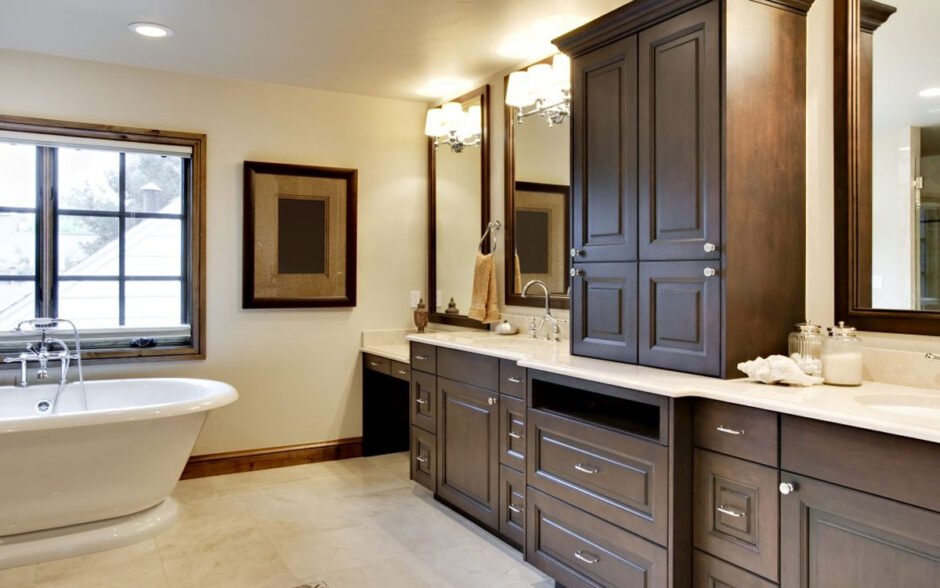A bathroom renovation succeeds or fails on storage and organization. Beautiful tile and upgraded fixtures matter, but if daily essentials have nowhere to go, the room quickly looks cluttered and feels smaller than it is. That’s why custom bathroom cabinets are such powerful upgrades. Built to your exact dimensions, routines, and design goals, they turn awkward alcoves into usable storage, tame countertop clutter, and add long-term value to your home. Unlike stock vanities that force you to adapt, custom cabinetry adapts to you.
Why Go Custom in the Bathroom?
Off-the-shelf vanities come in fixed widths and shallow storage configurations that rarely match real usage. Custom cabinetry lets you maximize every inch—wall-to-wall vanities, drawer banks sized for hair tools, hidden hampers, tall linen towers, toe-kick heat vents, integrated lighting, and outlet-in-drawer power for charging toothbrushes or razors. You also gain control over material quality, joinery, door style, stain or paint match, hardware placement, and interior accessories. For resale, a well-executed, built-in look signals craftsmanship and thoughtful design.
Planning the Perfect Layout
Start with how the bathroom is used. Two people getting ready at once? Consider dual sink bases separated by shared drawer stacks. Limited floor area? A shallow depth floating vanity can free walking space while making cleaning easier. Need vertical storage? Flank mirrors with tower cabinets or recess medicine cabinets between studs. Always map plumbing lines, electrical outlets, lighting heights, mirror clearances, swing paths for shower doors, and code requirements for receptacle distances before locking in cabinet dimensions.
Storage Strategies that Solve Everyday Clutter
Think in zones. Everyday countertop items (toothpaste, skincare) belong in top drawers with organizers. Bulk supplies (towels, paper goods) store best in deeper base or linen cabinets. Tall vertical pullouts can hold hair tools upright; tilt-out trays at sink fronts corral small items; roll-out trays under sinks bypass plumbing obstructions; built-in laundry bins isolate clothes from damp floors. If kids use the bath, include a lower drawer for step stools or bath toys. For accessibility, plan full-extension hardware and D-shaped pulls that open easily with wet hands.
Popular Materials & Construction Options
- Solid hardwood face frames: Durable, refinishable, and strong at hinge attachment points; species like maple, oak, poplar (paint-grade) are common.
- Plywood cabinet boxes: Resist moisture warping better than particle board and hold screws securely; ideal for bath environments.
- Furniture-grade MDF doors (painted): Smooth surface for painted finishes; stable when sealed properly.
- Veneered panels: Deliver consistent grain patterns while keeping costs below solid hardwood panels in large runs.
- Water-resistant finishes: Catalyzed conversion varnish, 2-part urethane, or marine-inspired seal systems improve moisture tolerance.
- Soft-close, full-extension hardware: Extends drawer life, improves access, and reduces slam damage in humid spaces.
Regional Style & Real-World Considerations
Local architecture often shapes cabinetry choices. Homes with deep window sills and thick plaster walls can accept recessed linen niches; newer builds may rely on frameless, space-efficient European boxes. Historic homes frequently require careful scribing to uneven floors and out-of-square walls—budget time and labor for site fitting. For example, homeowners comparing custom bathroom cabinets in Lancaster, PA often want cabinetry that blends farmhouse heritage with updated paints, inset doors, and moisture-ready finishes that handle seasonal humidity swings common to older masonry structures.
Key Questions to Ask Your Cabinet Maker
- What box materials do you use in wet environments, and how are edges sealed?
- How do you handle sink and plumbing cutouts to preserve structural strength?
- Are drawers dovetailed, doweled, or stapled—and what glides are specified?
- Which finish system protects against steam and routine cleaning products?
- Can you integrate electrical (in drawers, cabinets) and ventilation cutouts?
- What is the lead time from final approval to install, and how is field measurement handled?
Measuring, Lead Times & Installation Sequencing
Accurate field measurement typically happens after rough plumbing, electrical, and drywall but before final flooring if cabinet sits atop finished floor transitions. Confirm whether base height must align with vessel or undermount sinks; counter thickness affects finished faucet reach. Lead times for custom work often run 6–12 weeks depending on finish complexity. Coordinate delivery so cabinets acclimate indoors before installation—sudden humidity swings can cause door movement. Installers should shim level across the entire run, secure to studs, then template countertops. Schedule tile backsplash and plumbing trim after tops are set.
Moisture Protection & Care
Bathrooms generate steam and standing water, so cabinet longevity depends on moisture strategy. Elevate cabinets slightly from tile with adjustable legs or sealed plinths; caulk base perimeters where splash is expected. Use drip rails below vanity edges; choose sealed end panels near tubs and showers. Clean with non-abrasive, pH-neutral products; wipe standing water quickly; maintain exhaust ventilation to keep humidity in check. Refinish high-wear areas early rather than waiting for swelling or delamination.
Bringing Craft and Daily Function Together
Custom bathroom cabinets merge design intent with practical living. When built around daily habits—where you plug in grooming tools, how towels are stored, who shares the space—they eliminate clutter and speed up morning routines. Pair solid materials with proven waterproofing and a cabinet maker who documents every dimension before cutting wood. The result is cabinetry that fits perfectly, performs under moisture, and elevates the feel of the entire bath for years to come.









